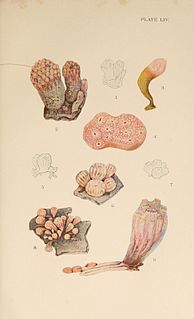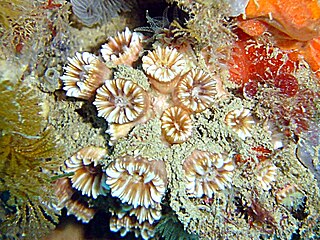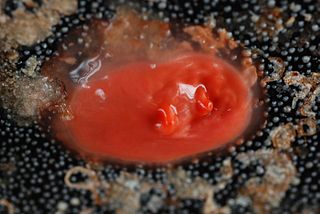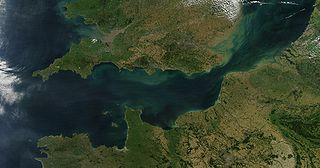
Pyrosomes, genus Pyrosoma, are free-floating colonial tunicates that live usually in the upper layers of the open ocean in warm seas, although some may be found at greater depths. Pyrosomes are cylindrical or cone-shaped colonies made up of hundreds to thousands of individuals, known as zooids. Colonies range in size from less than one centimeter to several metres in length. They are commonly called "sea pickles".

Porites astreoides, commonly known as mustard hill coral or yellow porites, is a colonial species of stony coral in the family Poritidae.

Halocyntia papillosa, also known as the red sea squirt is a sea peach or sea squirt, a species of tunicate.

Parazoanthus axinellae, commonly known as the yellow cluster anemone, is a zoanthid coral found on the southern Atlantic coasts of Europe and in the Mediterranean Sea. Zoanthids differ from true sea anemones, in having a different internal anatomy and in forming true colonies in which the individual animals (polyps) are connected by a common tissue, called the coenenchyme.

Aplidium californicum is a species of colonial sea squirt, a tunicate in the family Polyclinidae. It is commonly known as sea pork.
Aplidium solidum is a species of colonial sea squirts, a tunicate in the family Polyclinidae. It is commonly known as the red ascidian or sea pork.
Ecteinascidia turbinata, the mangrove tunicate, is a sea squirt species in the genus Ecteinascidia, which was described to science in 1880 by William Abbott Herdman. The cancer drug trabectedin is isolated from E. turbinata.

Atriolum robustum is a colonial tunicate or sea squirt in the family Didemnidae. It is native to the western and central Indo-Pacific where it is usually found anchored to a hard surface in shallow water.
Maritigrella crozierae, the tiger flatworm, is a species of marine polyclad flatworm in the family Euryleptidae. It is found on the eastern coasts of North America and the Caribbean Sea where it feeds on colonial sea squirts.

Didemnum vexillum, the carpet sea squirt, is a species of colonial tunicate in the family Didemnidae. Thought to be native to Japan, it has been reported as an invasive species in a number of places in Europe, North America and New Zealand. It is sometimes given the nickname "D. vex" because of the vexing way in which it dominates marine ecosystems when introduced into new locations, however the species epithet vexillum actually derives from the Latin word for flag, and the species was so named because of the way colonies' long tendrils appear to wave in the water like a flag.

Paragorgia arborea is a species of coral in the family Paragorgiidae, commonly known as the bubblegum coral. It grows in depths between 200 metres (660 ft) and 1,300 metres (4,300 ft) at temperatures between 2 °C (36 °F) and 8 °C (46 °F). It is found widespread in the northern Atlantic Ocean including on seamounts and knolls, and was first described by the Swedish naturalist Carl Linnaeus in 1758.

Electra pilosa is a species of colonial bryozoan in the order Cheilostomata. It is native to the northeastern and northwestern Atlantic Ocean and is also present in Australia and New Zealand.

Morchellium argus, the red-flake ascidian, is a species of colonial sea squirt, a tunicate in the family Polyclinidae. It is native to shallow water in the northeastern Atlantic Ocean, especially round the coasts of Britain.

Polyclinum aurantium is a species of colonial sea squirt, a tunicate in the family Polyclinidae. It is native to shallow water in the northeastern Atlantic Ocean and Mediterranean Sea.

Savalia savaglia, commonly known as gold coral, is a species of colonial false black coral in the family Parazoanthidae. It is native to the northeastern Atlantic Ocean and the Mediterranean Sea where it often grows in association with a gorgonian. It is extremely long-lived, with a lifespan of 2,700 years, and develops into a large tree-like colony.

Polycarpa pomaria is a species of tunicate or sea squirt in the family Styelidae. It is native to the northeastern Atlantic Ocean where it lives on the seabed at depths down to about 450 metres (1,500 ft).

Polycyathus muellerae is a small species of coral in the family Caryophylliidae in the order Scleractinia, the stony corals. It is native to the northeastern Atlantic Ocean and the Mediterranean Sea. It is a large polyp, colonial coral and grows under overhangs and in caves as part of an assemblage of organisms suited to these poorly-lit sites.
Corella eumyota, the orange-tipped sea squirt, is a solitary tunicate in the family Corellidae. It is native to the Southern Ocean, the Antarctic, South America, southern Australia, New Zealand and South Africa, and has been introduced into European waters where it has become invasive.

Prostheceraeus vittatus, the candy striped flatworm, is a species of marine polyclad flatworm in the family Euryleptidae. It is found in Western Europe, including on the western coasts of the British Isles.

Cnemidocarpa finmarkiensis is a species of solitary ascidian tunicate in the family Styelidae. Common names include broad base sea squirt, orange sea squirt, red sea squirt, shiny orange sea squirt, shiny red tunicate and Finmark's tunicate. It is native to shallow waters in the northern and northeastern Pacific Ocean.



















